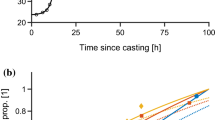Abstract
This article presents finite element modelling to predict the early age cracking risk of concrete structures. It is a tool to help practitioners choose materials and construction techniques to reduce the risk of cracking. The proposed model uses original hydration modelling (allowing composed binder to be modelled and hydric consumption to be controlled) followed by a non-linear mechanical model of concrete at early ages involving creep and damage coupling. The article considers hydration effects on this mechanical model, which is based on a non-linear viscoelastic formulation combined with an anisotropic, regularized damage model. Details of the numerical implementation are given in the article and the model is applied successively to a laboratory structure and to a massive structure in situ (experimental wall of a nuclear power plant studied in the framework of the French national research project CEOS.fr).












Similar content being viewed by others
References
Acker P, Ulm F-J (2001) Creep and shrinkage of concrete: physical origins and practical measurements. Nucl Eng Des 203:143–158
Bažant ZP, Prasannan S (1989) Solidification theory for concrete creep I. Formulation. J Eng Mech 115(8):1691–1703
Benboudjema F, Torrenti J-M (2006) Early age behaviour of concrete nuclear containments. In: 2nd edition of the international symposium on advances in concrete through science and engineering, RILEM Publication PRO 51, Quebec
Benboudjema F, Torrenti JM (2008) Early age behaviour of concrete nuclear containments. Nucl Eng Des 238(10):2495–2506
Bentz DP (2000) CEMHYD3D: a three-dimensional cement hydration and microstructure development modelling package. Version 2.0. NISTIR 6485, U.S. Department of Commerce, Washington, April 2000
Bernard O, Ulm F-J, Lemarchand E (2003) A multiscale micromechanics-hydration model fir the early age elastic properties of cement-based materials. Cem Concr Res 33:1293–1309
Bjøntegaard Ø, Sellevold EJ (1998) Thermal dilatation—autogenous shrinkage: how to separate? In: Autogenous shrinkage of concrete: proceedings of the international workshop of Hiroshima, Hiroshima, Japan, June 1998
Brooks JJ (2005) 30-Year creep and shrinkage of concrete. Mag Concr Res 57(9):545–556
Buffo-Lacarrière L, Sellier A (2009) Behaviour of HPC nuclear waste storage structures in leaching environment. In: Concrete in aggressive aqueous environments, RILEM TC 211-PAE final conference, Toulouse, France, 3–5 June 2009
Buffo-Lacarrière L, Sellier A, Escadeillas G, Turatsinze A (2007) Multiphasic finite element modelling of concrete hydration. Cem Concr Res 37(2):131–138
Cast3M (2005) CEA—DEN/DM2S/SEMT. http://www-cast3m.cea.fr/cast3m/index.jsp
De Schutter G (2002) Finite element simulation of thermal cracking in massive hardening concrete elements using degree of hydration based material laws. Comput Struct 80:2035–2042
Eierle B, Schikora K (1999) Computational modelling of concrete at early ages using DIANA. In: Diana-World 1999, issue 2. http://www.bst.bv.tum.de/pdf/diana.pdf
François D, Pineau A, Zaoui A (1991) Comportement mécanique des matériaux, vol 1. Hermès, Paris, ISSN 0986-4873
Gutsch A, Rostásy FS (1994) Young concrete under high tensile stresses—creep, relaxation and cracking. In: Thermal cracking at early ages, Rilem proceeding 25. Munich, Deutschland, ISBN 0-419-187103, pp. 111–119
Hauggaard AB, Damkilde L, Hansen PF (1999) Transitional thermal creep of early age concrete. J Eng Mech 125(4):458–465
Hillerborg A, Modeer M, Petersson PE (1976) Analysis of crack formation and crack growth in concrete by means of fracture mechanics and finite elements. Cem Concr Res 6:773–782
Ishikawa Y, Kunieda M, Srisoros W, Tanabe T (2005) Constitutive law based on solidification. In: Creep, shrinkage and durability of concrete and concrete structures (CONCREEP 7), Ecole Centrale de Nantes, Nantes, 12–14 September 2005
Kachanov LM (1986) Introduction to continuum damage mechanics. Martinus Nijhoff, Dordrecht. ISBN 90-247-3319-7
Lackner R, Mang HA (2004) Chemoplastic material model for the simulation of early-age cracking: from the constitutive law to numerical analyses of massive concrete structures. Cem Concr Compos 26:551–562
Laplante P, Boulay C (1994) Evolution du coefficient de dilatation thermique du béton en fonction de sa maturité aux tout premiers ages. Mater Struct 27:596–605 (in French)
Laube M (1990) Werkstoffmodell zur Berechnung von Temperaturspannungen in massigen Betonbauteilen im jungen Alter. Dissertation TU Braunschweig
Mabrouk R, Ishida T, Maekawa K (2004) A unified solidification model of hardening concrete composite for predicting the young age behavior of concrete. Cem Concr Compos 26:453–461
Onken P, Rostásy F (1995) Wirksame Betonzugfestigkeit im Bauwerk bei früh einsetzendem Temperaturzwang. DAfStb Heft 449. Beuth-Verlag, Berlin
Sanahuja J, Dormieux L, Chanvillard G (2007) Modelling elasticity of a hydrating cement paste. Cem Concr Res 37:1427–1439
Sellier A, Bary B (2002) Coupled damage tensors and weakest link theory for the description of crack induced anisotropy in concrete. Eng Fract Mech 69:1925–1939
Sellier A, Buffo-Lacarriere L (2009) Toward a simple and unified modelling of basic creep, shrinkage and drying creep for concrete. Eur J Environ Civil Eng 13(10):1161–1182
Smilauer V, Bittnar Z (2006) Microstructure-based micromechanical prediction of elastic properties in hydrating cement paste. Cem Concr Res 36(9):1708–1718
Stefan L, Benboudjema F, Torrenti J-M, Bissonnette B (2010) Prediction of elastic properties of cement pastes at early ages. Comput Mater Sci 47(3):775–784
Torrenti J-M, Bendoudjema F (2005) Mechanical threshold of cementitious materials at early age. Mater Struct 38(277):299–304
Ulm F-J, Coussy O (1998) Couplings in early-age concrete: from material modeling to structural design. Int J Solids Struct 35(31–32):4295–4311
Van Breugel K (1995) Numerical simulation of hydration and microstructural development in hardening cement-based materials. Cem Concr Res 25(2):319–331
Waller V, D’Aloïa L, Cussigh F, Lecrux S (2004) Using the maturity method in concrete cracking control at early ages. Cem Concr Compos 26:589–599
Yang Q-S, Li C-J (2006) Evolution of properties in hydration of cements: a numerical study. Mech Res Commun 33:717–727
Acknowledgments
The authors acknowledge the financial support of the French Group VINCI Construction Grands Projets (associated with ANRT for the CIFRE doctoral scholarship), of the French national program CEOS.fr and the French National Research Agency (ANR) under the MEFISTO research program (control of cracking in concrete structures—grant VD08_323065). We are also grateful to CEA/DEN/DM2S/SEMT for providing the finite element code CASTEM2005.
Author information
Authors and Affiliations
Corresponding author
Rights and permissions
About this article
Cite this article
Buffo-Lacarrière, L., Sellier, A., Turatsinze, A. et al. Finite element modelling of hardening concrete: application to the prediction of early age cracking for massive reinforced structures. Mater Struct 44, 1821–1835 (2011). https://doi.org/10.1617/s11527-011-9740-y
Received:
Accepted:
Published:
Issue Date:
DOI: https://doi.org/10.1617/s11527-011-9740-y




